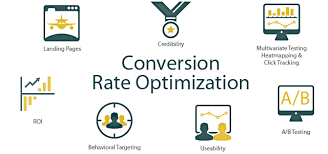The Art of Conversion Rate Optimization
Conversion Rate Optimization (CRO) is the practice of enhancing your website or landing page to increase the percentage of visitors who take a desired action, such as making a purchase, signing up for a newsletter, or filling out a contact form. It’s a crucial aspect of digital marketing that can significantly impact your bottom line.
Understanding the Basics
At its core, CRO involves analysing user behaviour, identifying areas for improvement, and testing different elements to determine what drives conversions. This can include tweaking call-to-action buttons, adjusting page layout, improving site speed, or refining your messaging to better resonate with your target audience.
The Benefits of CRO
By investing in CRO, you can maximise the value of your existing website traffic. Rather than focusing solely on attracting more visitors, CRO helps you make the most out of the users already landing on your site. This not only boosts conversion rates but also enhances user experience and customer satisfaction.
Key Strategies for Success
Successful CRO requires a data-driven approach. By utilising tools like Google Analytics and conducting A/B testing experiments, you can gather insights into user preferences and behaviour. This information allows you to make informed decisions about how to optimise your site for better results.
Continuous Improvement
CRO is an ongoing process that demands constant monitoring and refinement. What works today may not be as effective tomorrow, so it’s essential to stay agile and adapt to changing trends and user expectations. By continuously testing and iterating on your strategies, you can stay ahead of the competition and drive sustainable growth.
Final Thoughts
In today’s competitive digital landscape, conversion rate optimization is key to unlocking the full potential of your online presence. By focusing on improving conversion rates through strategic analysis and testing, you can enhance user engagement, increase sales, and ultimately achieve greater success in achieving your business goals.
8 Essential Conversion Rate Optimisation Strategies for Enhancing Your Website Performance
- 1. Analyse user behaviour on your website to identify areas for improvement.
- 2. A/B test different elements such as headlines, call-to-action buttons, and images.
- 3. Simplify the checkout process to reduce friction and increase conversions.
- 4. Use clear and compelling language to communicate value propositions effectively.
- 5. Optimise website speed for faster loading times, which can impact conversion rates.
- 6. Implement responsive design to ensure a seamless user experience across devices.
- 7. Leverage social proof through testimonials, reviews, and trust badges to build credibility.
- 8. Continuously monitor and refine your strategies based on data-driven insights.
1. Analyse user behaviour on your website to identify areas for improvement.
To enhance your website’s conversion rate, it is crucial to analyse user behaviour meticulously. By examining how visitors interact with your site, you can pinpoint specific areas that may require improvement. Understanding which pages users spend the most time on, where they drop off in the conversion funnel, and what actions lead to conversions can provide valuable insights for optimising your website effectively. This data-driven approach enables you to make informed decisions and implement changes that resonate with your audience, ultimately leading to higher conversion rates and improved user experience.
2. A/B test different elements such as headlines, call-to-action buttons, and images.
To enhance conversion rates effectively, consider implementing A/B testing on various elements of your website, including headlines, call-to-action buttons, and images. By comparing different versions of these key components and analysing the resulting user behaviour, you can gain valuable insights into what resonates best with your audience. This data-driven approach allows you to make informed decisions on which elements to optimise for maximum impact on conversions.
3. Simplify the checkout process to reduce friction and increase conversions.
To enhance conversion rates, a crucial tip is to simplify the checkout process, thereby reducing friction and encouraging more conversions. By streamlining the steps required for customers to complete their purchase, such as minimising form fields and providing clear instructions, businesses can create a seamless and efficient experience that motivates users to finalise their transactions. This simple adjustment can significantly improve conversion rates and ultimately lead to increased sales and customer satisfaction.
4. Use clear and compelling language to communicate value propositions effectively.
In the realm of conversion rate optimization, the tip to use clear and compelling language to communicate value propositions effectively holds immense significance. By articulating your offerings in a concise and persuasive manner, you can capture the attention of visitors and convey the unique benefits of your products or services. Clear communication not only enhances user understanding but also builds trust and credibility, ultimately leading to higher conversion rates and improved customer engagement.
5. Optimise website speed for faster loading times, which can impact conversion rates.
Optimising website speed for faster loading times is a crucial aspect of conversion rate optimization. Studies have shown that even a few seconds of delay in page loading can significantly impact user engagement and conversion rates. By ensuring that your website loads quickly and efficiently, you create a seamless user experience that encourages visitors to stay longer and take the desired action, whether it’s making a purchase or filling out a form. Investing in website speed optimization can yield tangible results in improving conversions and ultimately driving business growth.
6. Implement responsive design to ensure a seamless user experience across devices.
To enhance conversion rates, it is crucial to implement responsive design on your website. By ensuring that your site is optimised for various devices, including smartphones, tablets, and desktops, you provide a seamless user experience that adapts to different screen sizes and resolutions. This approach not only improves usability but also boosts engagement and encourages visitors to take the desired actions, ultimately leading to higher conversion rates.
7. Leverage social proof through testimonials, reviews, and trust badges to build credibility.
To enhance your conversion rate, consider leveraging social proof through testimonials, reviews, and trust badges. By showcasing positive feedback from satisfied customers and displaying reputable endorsements, you can establish credibility with potential visitors. Incorporating these elements into your website not only builds trust but also reassures users that they are making a reliable choice, ultimately increasing the likelihood of conversions.
8. Continuously monitor and refine your strategies based on data-driven insights.
To maximise the effectiveness of your conversion rate optimization efforts, it is essential to adhere to tip number 8: continuously monitor and refine your strategies based on data-driven insights. By regularly analysing key metrics and user behaviour, you can gain valuable insights into what is working well and what areas require improvement. This data-driven approach allows you to make informed decisions and adapt your strategies in real-time, ensuring that your website or landing page is always optimised for maximum conversions.


